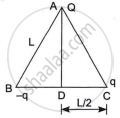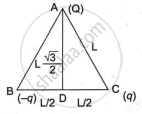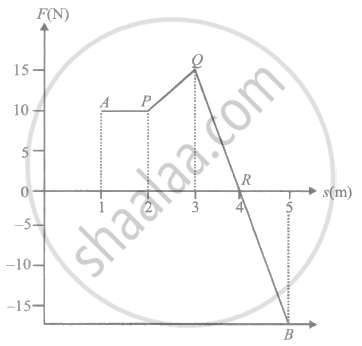Advertisements
Advertisements
प्रश्न
Three-point charges Q, q and -q are kept at the vertices of an equilateral triangle of side L as shown in the figure. What is

- the electrostatic potential energy of the arrangement? and
- the potential at point D?
उत्तर
- The electrostatic potential energy of the arrangement.
U = `1/(4piepsi_0)[((Q) xx (-q))/L + ((-q)(q))/L + ((q)(Q))/L]`
= `1/(4piepsi_0.L)[-qQ - q^2 + qQ]`
U = `-q^2/(4piepsi_0.L)` 
The potential at point D.
`V_D = 1/(4piepsi_0)[((-q))/(L"/"2) + q/((L"/"2)) + Q/(Lsqrt3"/"2)]`
`V_D = 1/(4piepsi_0) . (2Q)/(sqrt(3)L)`
⇒ `V_D = Q/(2sqrt3piepsi_0L)`
APPEARS IN
संबंधित प्रश्न
We know that electric field is discontinuous across the surface of a charged conductor. Is electric potential also discontinuous there?
Two point charges of 10C each are kept at a distance of 3m in the vacuum. Calculate their electrostatic potential energy.
Three point charges +q each are kept at the vertices of an equilateral triangle of side 'l'. Determine the magnitude and sign of the charge to be kept at its centroid so that the charges at the vertices remain in equilibrium.
Why must electrostatic field be normal to the surface at every point of a charged conductor?
A body moves from point A to B under the action of a force, varying in magnitude as shown in the figure. Force is expressed in newton and displacement in meter. What is the total work done?

Three point charges +2, +2, and +5µC are placed respectively at the vertices A, B, C of an equilateral triangle of side 0.2 m. The magnitude of the force experienced by the charge at C is ______.
A work of 100 joule is performed in carrying a charge of 5 coulomb form infinity to a particular. point in an' electrostatic field. The potential of this point is:-
In bringing one electron towards another electrons, the electrostatic potential energy of the system will.
A point charge q0 is moving along a circular path of radius a, with a point charge Q at the centre of the circle. The kinetic energy of q0 is ______.
